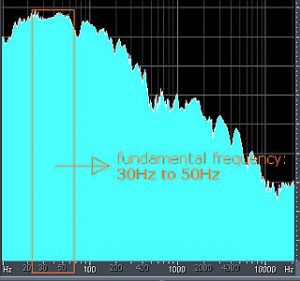Hi, I’ve subscribed to your website and it has really been helpful. I am based in Africa and in my country there isn’t any legitimate sound engineering school. I’ve been making beats for about 8 years now. I would like to know the basic standard frequencies for:
The Kick drums (hip hop and RnB)
The Hi-Hats
The snare
The crash cymbal
Thank you
———-
My reply:
Theory about central frequency of every drum instrument
Thank you for writing and subscribing to www.audiorecording.me. First let give you a theory about central (or fundamental) frequencies which are discussed in the musical instrument frequency range analysis. The frequency response of any drum instrument can be approximated by this graph:
At Emax is where the central frequency of the instrument will be located. This is the strongest and dominant frequency that you should know. The purpose is to have your EQ adjustments to be as accurate and effective as possible. Central frequency is what gives the drum instrument a distinct and identifiable sound in the mix. Kick and bass drum tends to have central frequencies in the bass/subwoofer frequency range. Snare drums tend to have its central frequency in the mid-frequency range. And finally hi-hats and cymbals tend to have its central frequency in the upper frequency range (treble).
However, the central frequency at Emax is DIFFERENT for EVERY DRUM RECORDING SESSION. This is because recording techniques have strong influence on the final/resulting instrument sound. Like how you place the microphone in the bass drum could affect its central frequency response. If you put the microphone nearer to the kick pedal, it tends to have different sound than placing the microphone significantly farther. Another example is the way how you put the microphone on the snare drum. Also the type and skin of the snare drum can also affect the resulting central frequency. And even different brands of drum kit can have different sound. This goes to say that:
“Central frequencies of drum instruments at which you can cut and boost using EQ depends on the recorded material, the type of drum materials used and the manner how they are recorded”
Therefore; there is no fixed and general EQ/frequency rule that applies to all drum recordings. If you attempt to generalize frequencies for all of your drum tracks during mixing, you cannot fix EQ problems effectively. The primary reason is that each of the drum tracks might be recorded using different techniques that results to different resulting sound. So how can you be so sure that you are adjusting the correct central frequency?
First Method: Perform Frequency Spectrum Analysis
The first approach is that you can perform an audio spectrum analysis on your recorded drum tracks to check the central frequency. This is mostly available in most recording software. This will give a plot of frequency vs. amplitude. The highest peaks in the graph are the central frequencies that you can cut and boost using parametric EQ. For example this is the frequency spectrum analysis result of a bass hip hop/RN’B drum:

